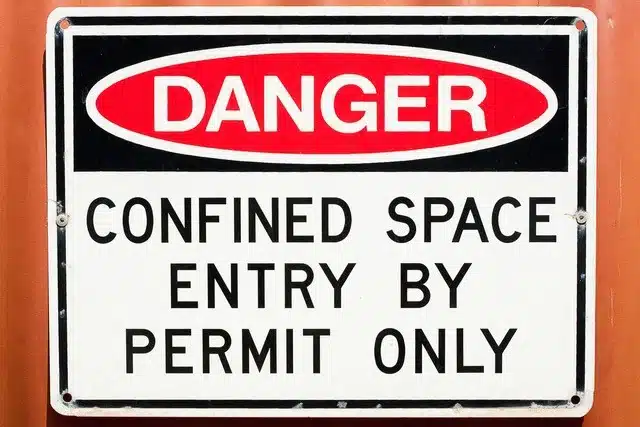Navigating Safety in Confined Spaces: A Guide for Construction Workers
Construction sites are bustling hubs of activity, with various tasks and projects unfolding simultaneously. While much attention is given to the grand structures being erected, it’s crucial to recognize the safety of the workers who are integral to the process. One particularly hazardous aspect of construction work is confined spaces, where the risks can be significantly amplified.
Understanding Confined Spaces:
Confined spaces include areas with limited access and egress, not designed for continuous occupancy, and/or contain or have the potential to contain a hazardous atmosphere. They can be found in trenches, tunnels, tanks, vessels, silos, storage bins, hoppers, vaults, pits, manholes, ductwork, crawl spaces, pipelines, etc. These spaces often present dangers such as entrapment, engulfment, poor ventilation, limited visibility, and the potential for a hazardous atmosphere. OSHA uses the term “permit-required confined space” to describe a confined space that has one or more of the following characteristics:
- Contains or has the potential to contain a hazardous atmosphere.
- Contains material that has the potential to engulf an entrant.
- Has walls that converge inward or floors that slope downward and taper into a smaller area, which could trap or asphyxiate an entrant.
- Contains any other recognized safety or health hazard, such as unguarded machinery, exposed live wires, or heat stress.
The Importance of Safety:
The hazards associated with working in confined spaces cannot be underestimated. These include, but are not limited to:
- Lack of Ventilation: Limited air circulation can lead to decreased oxygen levels or increased harmful gases, putting workers at risk of asphyxiation.
- Engulfment: Some confined spaces, such as trenches, can collapse without warning, burying workers beneath the debris.
- Toxic Atmospheres: Accumulation of gases, fumes, or chemicals can create toxic environments that may cause severe health issues or even death.
- Physical Entrapment: Workers might become stuck due to the size and shape of confined spaces, making it difficult to escape in emergencies.
- Fire and Explosion: The presence of flammable substances can lead to fire or explosions.
The Heartbreaking Tale of a Confined Space Workplace Accident:
Two utility contractor employees tragically lost their lives while engaged in the installation of water lines. The unfortunate incident occurred within a 12-foot deep shaft, which lacked sufficient oxygen levels. It is believed that one of the workers began experiencing breathing difficulties, prompting his co-worker to descend into the shaft to assist him. Unfortunately, both individuals succumbed to the lack of oxygen and were declared deceased at the scene.
This heartbreaking incident shines a spotlight on the failure of safety measures within the company. OSHA imposed fines against the company for its blatant disregard of safety standards and failure to adequately protect its workers. This accident underscores the importance of adhering to rigorous training, providing appropriate equipment, and meeting all requirements when working within confined spaces. This tragedy could have been prevented with the proper precautions and safety protocols.
Guidelines for Staying Safe:
To mitigate the risks associated with working in confined spaces during construction, it’s essential to adhere to stringent safety protocols. Employers are required to have a thorough confined space safety program in place. Here are some guidelines:
- Written Program: Employers must develop and implement a written program for the confined space, including procedures and practices to eliminate or control hazards. Documents must be thorough and include safety policies, rescue procedures, each confined space’s unique hazards, atmospheric testing procedures, record keeping, incident reporting, respiratory protection, etc.
- Risk Assessment: Conduct a thorough assessment of the confined space before entry. Identify potential hazards, test the air quality, and ensure proper ventilation. The confined space must be assessed for all real and potential hazards. Do not overlook configuration hazards that could entrap or suffocate an entrant with inwardly converging walls or floors, atmospheric hazards, engulfment hazards, electrical hazards, mechanical hazards, chemical hazards, steam hazards, extreme temperatures, slippery floors, poor lighting, and noise. Perform a pre-entry briefing and use the decision-making flowchart for permit-required confined spaces. Inform employees and contractors of the permit-required confined space.
- Atmospheric Testing: Determine what chemicals are present in the confined space. Use a technically qualified professional, such as a Certified Industrial Hygienist or a Certified Safety Professional, to ensure safe atmospheric conditions.
- Proper Training: Employers must provide safety training before work begins in permit spaces. Workers involved must receive training specific to working in confined spaces. This training should cover recognizing hazards, using safety equipment, and understanding emergency procedures. Workers should also be trained on the hierarchy of controls, keeping in mind that if work can be done outside of the confined space, that is the best option. Rescue team members also require CPR and first aid training.
- Effective Communication: Inform employees and contractors of the permit-required confined space.Establish clear communication methods between workers inside and outside the confined space. This can include two-way radios, hand signals, or designated alarm systems.
- Use of Safety Equipment: Ensure workers wear appropriate personal protective equipment (PPE), including respiratory protection, harnesses, lifelines, and gas detectors. Equipment for safe entry, such as testing, monitoring, ventilating, communications, and lighting equipment, should also be used. Plan for barriers, barricades, rescue equipment, ladders, and retrieval devices that will be used.
- Continuous Monitoring: Keep a constant watch on workers inside confined spaces. Assigned duties include authorized entrant, attendant, entry supervisor, and rescue service personnel.
- Prevent Unauthorized Entry: Post confined space notification signs and use barricades to prevent unauthorized entry. Have a procedure in place to prevent unauthorized personnel from attempting a rescue. Often, in confined spaces, an employee who is unaware that the atmosphere in the confined space is dangerous will attempt to rescue his or her co-worker and become a second victim.
- Emergency Plans: Develop and communicate well-defined emergency procedures. Workers should be trained to respond promptly to unexpected situations. Conduct confined space rescue drills and scenarios.
- Proper Ventilation: Maintain adequate airflow to prevent the buildup of toxic gases and ensure proper oxygen levels.
- Safe Entry and Exit: Install sturdy ladders, stairs, or other means of entry and exit. These should be easily accessible and regularly inspected for damage.
- Lockout/Tagout: Isolate and lock out any equipment that could start unexpectedly and endanger workers inside the confined space.
- Regular Inspections: Periodically inspect confined spaces to identify changes in conditions that could pose risks.
Construction sites are dynamic environments, and staying safe within confined spaces is vital to maintaining worker well-being. By understanding the potential hazards and following strict safety protocols, construction teams can mitigate risks and create a secure working environment. Continuous training, effective communication, and adherence to established guidelines ensure that confined space work remains productive and, most importantly, safe for everyone involved. Contact us today if you need help with your confined space safety program. We offer confined space safety training, including entrant, attendant, and supervisor training, which addresses the OSHA confined space standard and written programs. Call us at 919-417-2139; our Certified Safety Professionals can answer your questions and help you get started today.


